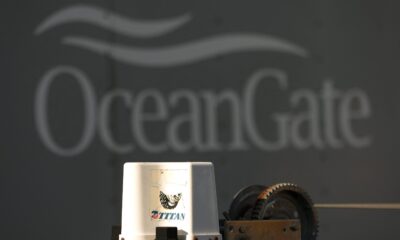Travel
Tourists could be fined €750 for not following these etiquette rules in Malaga
Locals say their hometown has become a theme park for tourists.
Malaga is one of Spain’s most popular summer destinations, receiving around 14 million visitors in 2023.
But overtourism has become so disruptive for residents that this summer saw protests and anti-tourism campaigns in the Costa del Sol city.
Activists say their hometown has become a theme park for tourists and have spoken out about the swathes of badly behaved visitors who come to the Andalusian destination for clubbing and nightlife.
The post-pandemic tourism boom has also pushed locals to the limit by distorting the rental market and gentrifying the city centre.
In response, Malaga local council has updated tourism rules and launched a poster campaign in both English and Spanish to remind visitors of appropriate and inappropriate behaviour.
Authorities underline that following these regulations improves life for residents and means tourists have a better experience.
From street safety to clothing no-nos, there are the latest rules for visitor etiquette in Malaga.
Dress completely
Authorities remind visitors to always wear an “upper garment” in the streets and public places.
After residents complained about tourists that frequently walk around the city centre in swimming costumes or shirtless, a bylaw was introduced in 2023 making the practice illegal.
It is now forbidden to be seen without a top or in underwear in public, with fines of up to €750 for violations.
Do not be conspicuous
This rule refers to visitor behaviour that can be considered disruptive or inappropriate in residential areas. The council advises tourists not to shout, sing or play music loudly.
It asks that visitors be particularly aware of respecting the hours of the day when residents are resting and be considerate of the elderly, sick, children, students and essential workers.
Pavements are for pedestrians
Authorities ask that anyone using bicycles or scooters stick to “spaces legally designed for this purpose” rather than taking up space on pavements which are intended only for pedestrians.
Keep the city clean
The online and billboard campaign asks visitors to use garbage cans, containers and other services when disposing of rubbish.
It also emphasises that particular care not to litter should be taken around monuments, historical attractions, parks and gardens.
Travel
No more free food on flights? This European airline is trialling a buy-on-board programme
This airline will no longer serve free meals on certain flights.
Whether you love or hate in-flight meals, there’s no denying the jingle of the trolly breaks up the monotony of a long journey.
But free snacks could be the next casualty of airlines’ cost-cutting measures as another European carrier plans to scrap them in a new trial.
Air France, a subsidiary of the Air France-KLM Group, will test out a new buy-on-board system for food and drinks on some of its short and medium-haul flights from 2025.
Currently, the airline offers an edge over budget carriers like Ryanair and easyJet by providing a free drink and sandwich, snack or pastry on most of its economy class flights – depending on the duration.
Which Air France routes will stop providing free food?
Currently, Air France passengers can purchase a la carte meals when booking or up to 24 hours before departure. Looking ahead, they may have the option to buy on board.
Initially, the optional paid catering system will be introduced on Air France’s routes from Paris-Charles de Gaulle to Helsinki and Lisbon.
It is yet to be seen whether the cost savings will translate into lower ticket prices or whether it will be rolled out across other routes.
Not all will be lost, however: passengers will still be offered water or a hot drink with a small sweet or salty snack.
Business class passengers will be unaffected by the change, and will still receive a complimentary meal alongside hot and cold drinks and a selection of alcoholic beverages.
Do other European airlines still give out free food?
Free food has gradually been phased out on most short- and medium-haul flights since budget airlines like Ryanair pioneered the pay-on-board model in the 1990s.
In recent years, full-service global airlines like British Airways and Lufthansa have adopted the system for shorter flights.
The Netherlands’ flag carrier KLM was also recently revealed to be considering removing complimentary catering for economy passengers.
Charging a fee would allow the airline to expand its on-board food offerings, a spokesperson told Dutch aviation magazine Luchtvaartnieuws.
Scrapping complimentary in-flight catering could have a silver lining: reducing food waste. In 2023, IATA found that 1.14 million tonnes of food waste was generated from in-flight catering annually.
It will also help to remove the temptation for those wishing to try the controversial ‘raw-dogging’ trend, which sees passengers forgo entertainment, food and drinks in a bid for a more ‘mindful’ flying experience.
Travel
Bulgarian Communist monument that attracts 50,000 urban explorers a year eyed as tourism attraction
The UFO-shaped Buzludzha monument was abandoned after the fall of the Communist regime in Bulgaria.
The colossal Buzludzha monument crowns the top of a mountain peak outside the Bulgarian town of Kazanlak.
The UFO-shaped structure which stands alongside a monumental tower was built between 1971 and 1984 to celebrate the founding of the Bulgarian Social Democratic Party.
After the fall of the Communist regime, the building was abandoned and left to crumble.
In recent decades, its eerie, deteriorating interiors have attracted thousands of curious visitors and garnered social media fame.
Now, Kazanlak local council is proposing purchasing the spectacular structure to increase its popularity as a tourism destination.
Communist-era monument attracts 50,000 urban explorers a year
Authorities in Kazanlak say they will ask residents to vote on whether the council should purchase the Communist memorial structure.
The Buzludzha monument is in an unstable condition and entry is prohibited.
But that doesn’t stop it from attracting roughly 50,000 visitors a year including urban explorers and photographers.
The decaying structure has garnered internet fame and often features on social media accounts dedicated to abandoned places.
It hasn’t gone unnoticed by heritage organisations, either. In 2020, an international team of restorers began work to repair and preserve the interior mosaics.
The wall designs exalting Communist values and leaders are made up of more than two million tiles and cover an area of around 1,000 square metres.
Over the years, the dome has partially collapsed leaving these mosaics at the mercy of the elements.
Abandoned Buzludzha monument to bring tourism fame to Bulgarian town
The mosaic restoration has been privately funded, so the proposal from Kazanlak council marks the first time that a public body has expressed interest in the monument.
Mayor of Kazanlak Galina Stoyanova says she wants to invest €3.5 million from the EU Recovery Plan in the restoration of the building and its transformation into a tourist attraction.
The saucer-shaped structure is currently owned by the Bulgarian state.
It was previously in the hands of the Bulgarian Socialist Party, which did not have the funding to protect the memorial which celebrates the 1,300th anniversary of the creation of the first Bulgarian state and the 90th anniversary of the founding of the first Socialist Party.
Despite increasingly becoming valued as an architectural and cultural asset, the monument remains controversial.
It is still a potent political and ideological symbol and nearby mountain slopes continue to be used for annual gatherings of Bulgarian Socialists.
Should the mayor’s proposal be approved, a referendum will be held on 17 November for residents to vote on whether the council should purchase the monument.
Travel
Is the Entry/Exit Scheme delayed again? What travellers need to know about new EU border checks
If the EES becomes operational in autumn, non-EU travellers entering the Schengen Area will have to go through new scanners at EU borders.
The EU’s post-Brexit Entry/Exit System (EES) is due to launch in November, but recent reports suggest it may face further delays.
In August, EU Home Affairs Commissioner Ylva Johansson confirmed the border checks would come into force on 10 November.
“The moment is finally there. There may have been times you believed it will never happen,” Johansson said during a visit to the Tallinn-based eu-LISA, the EU agency in charge of the IT infrastructure behind the EES.
“But it’s going to happen. Everything is coming together. We’re in the final testing phase. There is a real momentum now. Carriers, operators, train stations, airports, everyone is getting ready for the big day.”
The EES was first slated to launch in 2022 but has faced multiple setbacks due to IT issues and delays in installing the automated barriers required at all international land, maritime and air borders in the Schengen Area.
A new report in UK newspaper the Guardian suggests there may now be further delays as three countries raise concerns about the lack of trials of onsite trials of the technology.
Germany, France and the Netherlands are believed to have said they are not ready to introduce the system.
As yet, there has been no official update from EU authorities with Frontex, the Border and Coast Guard Agency, declining to comment.
When the new system does become operational, non-EU travellers entering the Schengen Area will face new border controls.
Which travellers will need to use the EES?
The Entry/Exit Systemwill be an automated registration system for UK and other non-EU travellers who don’t require a visa to enter the EU.
Travellers will need to scan their passports or other travel document at a self-service kiosk each time they cross an EU external border. It will not apply to legal EU citizens or residents or those with long-stay visas.
The system will register the traveller’s name, biometric data, and the date and place of entry and exit. Facial scans and fingerprint data will be taken every three years and are valid for multiple trips within that period.
It will apply when entering all EU member states, apart from Cyprus and Ireland, as well as four non-EU countries in the Schengen Area: Iceland, Lichtenstein, Norway and Switzerland.
The EES is being introduced to bolster border security and identify travellers who overstay their permitted time in the Schengen Area (90 days within a 180 day period).
“With the EES we will know exactly who enters the Schengen area with a foreign passport,” Johansson said.
“We will know if people stay too long, countering irregular migration. And the EES will make it harder for criminals, terrorists or Russian spies to use fake passports thanks to biometric identification, photos and fingerprints.”
Will the EES cause travel delays?
In the UK and elsewhere, there are concerns that the EES could increase delays at border checkpoints.
In a European Council report released by non-profit Statewatch, various countries express concern over the EES implementation delays. Last year, they said the amount of time they will have to test the system prior to its launch was rapidly decreasing.
French authorities will operate EES border checks at the UK’s Port of Dover, Eurostar and Eurotunnel. They are currently working with the UK government to minimise the system’s impact on border flows and traffic, but express concern about potential waiting times.
Government agencies and representatives for the tourism industry have said that the EES will likely cause long queues for ferry traffic sailing from Dover to Calais.
Guy Opperman, a minister in the UK’s transport department, has since explained the scheme will have a “six-month soft launch” to make the process more simple.
“If one got to a situation where there were a certain amount of queues or delays, then the provisions of the precautionary flexibility measures allow for much greater freedom of passage of vehicles, coaches, HGVs and cars,” he said. “That takes care of so much of the queuing, so many of the complications.”
Other countries are still working on EES implementation plans, too. The European Commission has suggested that the system may need to be introduced in a gradual and flexible way to reduce the likelihood of long waiting times at borders.
Is ETIAS still on track?
Roughly six months after the launch of the EES will see the introduction of the European Travel Information and Authorisation System (ETIAS).
This new scheme obligates non-EU citizens who do not require an EU visa to gain travel authorisation to enter the bloc (as opposed to the EES which is a monitoring system of border crossings by third-country nationals). The visa waiver will be mandatory for anyone wishing to visit the Schengen Area short term.
ETIAS was originally set to be operational from November 2023. However, the European Commission now states that it will come into force in 2025.
While an exact date is not provided, the EU has previously indicated that it will be introduced five to six months after EES. There may be an implementation period where it is gradually introduced alongside the Entry/Exit System.
Travellers will be able to apply for ETIAS online before their trip at a cost of €7. Once approved, the electronic travel authorisation will be electronically linked to their passport and will last for three years.
Click here for full details on the ETIAS.
-

 EU & the World3 days ago
EU & the World3 days agoOceanGate Titan Sub Hearings: Everything Revealed on Wreckage from Testimony
-

 Sports4 days ago
Sports4 days agoGenoa, Alberto Gilardino against Venezia wants determination
-

 EU & the World4 days ago
EU & the World4 days agoNicholas Alexander Chavez: 5 Things About the Actor Playing Lyle Menendez
-

 EU & the World4 days ago
EU & the World4 days agoGeorgia Abortion Ban: Delayed Abortion Care Leads to Death of Amber Thurman
-
EU & the World3 days ago
‘Monsters: The Lyle and Erik Menendez Story’ Cast: Meet the Actors
-

 Sports6 days ago
Sports6 days agoSamuel Vincent Ruggeri, the sparring partner surprised by Jannik Sinner
-

 Sports4 days ago
Sports4 days agoSportal.co.uk exclusive: Thomas Ceccon explains mustache-gold medal exchange
-

 Sports4 days ago
Sports4 days agoLaver Cup, Francisco Cerundolo leads Rest of World over Europe









